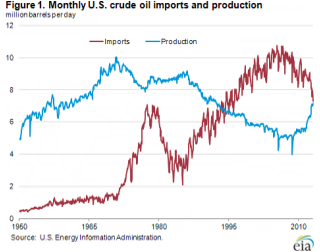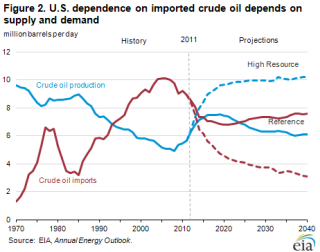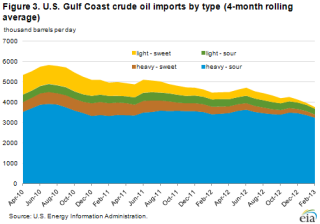Released: May 1, 2013
Next Release: May 8, 2013
Absorbing Increases in U.S. Crude Oil Production
U.S. crude oil production has been rising in recent years following a decline from 9 million barrels per day (bbl/d) in 1985 to 5 million bbl/d in 2008 (Figure 1). Production was 6.5 million bbl/d in 2012 and EIA's latest Short-Term Energy Outlook forecasts production of 8.2 million bbl/d by the end of 2014, driven by the continued rapid pace of tight oil development that almost exclusively produces light crude.
While long-term projections are inherently uncertain, reflecting assumptions about hydrocarbon resources as well as advances in technology, U.S. crude production in the High Oil and Gas Resource case of EIA's Annual Energy Outlook 2013 averages 10 million bbl/d over the 2020 to 2040 period (Figure 2), with light grades of crude oil providing the bulk of output growth.
Some recent commentary has suggested that it was likely or even inevitable that the growth in U.S. oil production from tight resources would be significantly curtailed unless there was a relaxation of current U.S. policies toward crude oil exports. However, this is likely an overstatement of the actual situation, because there are several other midstream and downstream adjustments that could help to accommodate changing production patterns.
Recent Developments
The growing supply of domestic light crude oil in the mid-continent that has traditionally moved through the Cushing, Oklahoma, market hub has already prompted both midstream and downstream changes. Pipelines like Seaway that were once used to carry imported oil up from Gulf Coast ports to reach Midwest refiners have been reversed and are moving inland crude oil down to the Gulf, and their capacity is being dramatically expanded. New pipeline infrastructure is also under construction, including the southern portion of the Keystone XL project, which is slated to be in operation by year-end, and more has been proposed.
There have also been major developments in rail transport, where shipments of crude increased dramatically in 2012 compared to 2011. Rail is generally more costly than pipelines for crude oil transport, but unit train loading and unloading facilities, which can often be built quickly and without many regulatory hurdles, can help to narrow the gap between rail and pipeline shipment costs. Rail also can provide greater flexibility in destination points. For example, while most of the major pipelines that are under discussion focus on linking inland crude streams with the U.S. Gulf Coast, home to about half of the nation's refining capacity, some of the less-complex refineries on the East Coast and in the Northwest that have historically run imported light sweet crude provide attractive opportunities for switching to domestic light tight oil. Rail shipments to take advantage of these opportunities have already begun, and are likely to increase significantly in the near future.
Even with these midstream adjustments, continued strong growth in U.S. production of light crude oil from tight resources raises the prospect of a quality mismatch between domestic crude supplies and refinery capabilities. Many Gulf Coast refineries, and increasingly those in the Midwest and West Coast, have invested in secondary upgrading units that are used to convert heavy sour crudes into high-margin petroleum products. Heavy sour crudes are very attractive to these refiners, both because they yield slates rich in diesel and other distillates that are in high demand and because heavy crudes typically sell at a discount to light sweet grades on world markets. For this reason, refiners with upgrading capability are very interested in increasing their runs of heavy crude, including that produced from Canadian oil sands.
At the same time, U.S. refinery closures in recent years, largely concentrated along the East Coast, have reduced the amount of capacity optimized to run light sweet crude. To date, the increase in U.S. light sweet crude production has been accommodated by displacing imports. However, with light sweet crude imports (35 degrees API or higher and sulfur under 0.5 percent) to the Gulf Coast in February 2013 (the latest data available) running at 80,000 bbl/d, and total U.S. light sweet crude imports at only 500,000 bbl/d, the opportunity for like-for-like displacement of light sweet imports is running out (Figure 3). If imports of light, higher-sulfur crude oil are also replaced by domestic light production, an additional 440,000 bbl/d of imports could be displaced.
Future Options
Under current law and regulations, crude oil produced in the United States requires a license to be exported. Exports to Canada for processing or consumption in Canada, as well as certain specific U.S. crude streams (such as California heavy crudes), are presumed to automatically qualify for export licenses, subject to meeting specific restrictions such as volume limitations. Beyond these established and well-known exceptions, the common understanding has been that crude oil export licenses would be hard to come by. On the other hand, the United States generally allows exports of petroleum products without a license.1
There are market reasons that make it attractive to both import foreign-produced crude oil and export domestically produced crude oil in order to maximize the value of crude production and refining capabilities. For example, the United Kingdom is a net crude oil importer, but is also an exporter of Brent crude. While a change in export policy is one option, some combination of the following outcomes could occur in a hypothetical situation with high production growth of domestic light tight oil and no changes in current export licensing policies:
• Exports of light sweet crude oil to Canada, which trade press reports indicate are already up, could continue to rise. However, depending on how greatly light, tight production grows, the markets that can be reached under current export licensing policies may be too small to alleviate the impending mismatch.
• U.S. light sweet crude could be priced at a sustained discount relative to comparable international seaborne crudes by an amount sufficient to encourage its use in refineries along the Gulf Coast that are optimized for heavier crudes. This possibility, which was mentioned in an April 24, 2013, TWIP article that addressed pricing differentials between Louisiana Light Sweet and Brent crudes, would imply lower wellhead prices for domestic light crude streams. Depending on the level of world oil prices and the size of differentials between global and domestic crude prices, lower prices could reduce the level of domestic production.
• In the short-run, U.S. refiners that switch from heavy to light crude may need to reduce their total volume of refinery runs given operating constraints that limit their ability to handle light fractions. Over time, these refineries may invest capital to increase the capability to run light crudes. For example, they may increase capacity to process light ends from distillation to avoid reducing crude input volume when running light crudes.
• Complex refineries in the United States may idle or cut back the use of cokers and other secondary processing units designed to support heavy crude processing. This could create processing bottlenecks and/or shifts in product slates.
• Markets for diesel fuel and other distillates could tighten if the switch from heavy to light inputs at complex refineries reduces the share of distillates in the output slate. Conversely, supplies of gasoline, which are currently in surplus in world markets, could rise.
• Refiners or other processors may elect to partially process some domestic light crude to produce material that could be classified as a petroleum product or feedstock rather than as crude oil. Since such products are generally not subject to export licensing requirements, they could be exported under the current policy regime.
As television announcers used to say, "Stay tuned."
Gasoline and diesel fuel prices down for a ninth consecutive week
The U.S. average retail price of regular gasoline decreased two cents to $3.52 per gallon as of April 29, 2013, down 31 cents from last year at this time. Prices were lower in all regions of the nation except the Midwest, where the price increased less than a penny to remain at $3.55 per gallon. The largest decrease came on the West Coast, where the price declined four cents to $3.80 per gallon. Dropping three cents, the Gulf Coast price is $3.30 per gallon. On the East Coast the price is $3.46 per gallon, two cents lower than last week. Rounding out the regions, the Rocky Mountain price decreased less than one cent to $3.48 per gallon.
The national average diesel fuel price decreased four cents to $3.85 per gallon, 22 cents lower than last year at this time. The largest decrease came on the Gulf Coast, where the price decreased five cents to $3.76 per gallon. The West Coast price is $3.95 per gallon, the East Coast price is $3.89 per gallon, and the Rocky Mountain price is $3.81 per gallon, all down four cents from last week. Declining three cents, the Midwest price is $3.84 per gallon.
Propane inventories gain
Total U.S. inventories of propane increased 1.5 million barrels last week to end at 40.5 million barrels, but are 8.0 million barrels (16.6 percent) lower than the same period a year ago. The Midwest region led the gain with 0.9 million barrels, while Gulf Coast stocks increased by 0.4 million barrels. East Coast inventories increased by 0.2 million barrels, and Rocky Mountain/West Coast inventories gained 0.1 million barrels. Propylene non-fuel-use inventories represented 9.5 percent of total propane inventories.
Text from the previous editions of This Week In Petroleum is accessible through a link at the top right-hand corner of this page.
 |
 |
||||||
| Retail Data | Change From Last | Retail Data | Change From Last | ||||
| 04/29/13 | Week | Year | 04/29/13 | Week | Year | ||
| Gasoline | 3.520 | Diesel Fuel | 3.851 | ||||
 |
 |
||||||||||||||||||||||||||
|
 |
||||||||||||||||||||||||||
| *Note: Crude Oil Price in Dollars per Barrel. | |||||||||||||||||||||||||||
 |
 |
||||||
 |
 |
||||||
| Stocks Data | Change From Last | Stocks Data | Change From Last | ||||
| 04/26/13 | Week | Year | 04/26/13 | Week | Year | ||
| Crude Oil | 395.3 | Distillate | 115.8 | ||||
| Gasoline | 216.0 | Propane | 40.476 | ||||


